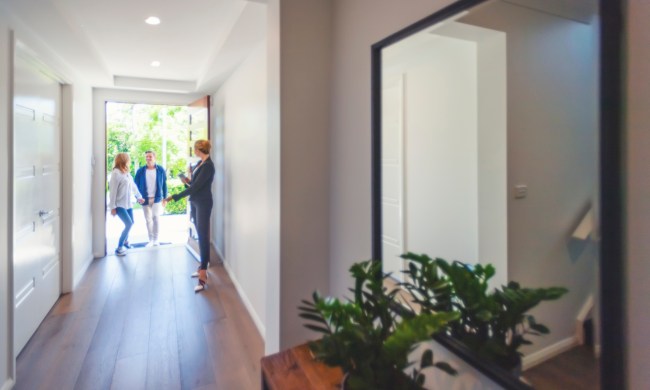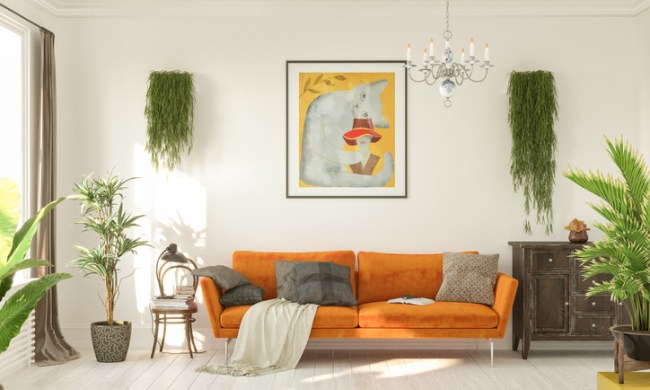If you’ve been wondering how to make small spaces look bigger, you’re not alone. Whether you live in a studio apartment or a compact home, maximizing your space through smart design choices can make a huge difference. From color palettes to lighting techniques, simple tweaks can help you create the illusion of openness and airiness — even when square footage is limited.
The good news? You don’t need a huge renovation budget to make your small space more inviting. With the right design strategies, even the tiniest room can feel expansive and inviting.
What color makes a small room look bigger?

Color has a powerful effect on how we perceive space. In fact, the right color scheme can visually stretch your room, making it appear more open and airy. Here are a few color strategies to keep in mind.
Choose light, airy colors
Lighter shades reflect more light, which instantly opens up a room. Whites, creams, soft grays, and pastels bounce natural and artificial light throughout the space, creating a brighter, more expansive feel. Light blues and green hues can also create a calming effect that visually extends your walls.
Go with a neutral color palette
Classic neutral tones are timeless — and when used correctly, they’re space-enhancing, too. Beige, greige, taupe, and soft gray all serve as perfect backdrops for small rooms. They don’t compete for attention and allow the eye to move freely around the room, which makes everything feel a bit more spacious.
Make it monochrome to blur lines and open the space
Going with a monochrome color scheme means using different shades of the same color throughout the room — walls, ceilings, trim, and even furniture. When you keep everything in the same tonal family, the boundaries between surfaces blur. This subtle trick eliminates visual breaks and makes the space feel more cohesive and less confined. Matching the wall color to furniture tones also helps pieces blend in, making the room look less cluttered.
Furniture choices: How to make small spaces look bigger

Your furniture selection can drastically impact how large — or how cramped — a room feels. Smart furniture choices are essential when you’re figuring out how to make small spaces look bigger.
Choose size over quantity
While it may seem logical to furnish a small space with small furniture, that often creates more visual clutter. Instead, opt for larger statement pieces and fewer of them. A single sizable couch, for example, can anchor the space more effectively than several smaller chairs. It’s about streamlining your layout without overcrowding it.
Opt for glass furniture pieces
Clear or glass furniture creates a sense of openness because it doesn’t visually block the room. A glass coffee table, acrylic chairs, or a Lucite desk helps maintain the flow of the room, making it feel lighter and less segmented. This trick allows the eye to travel through the furniture instead of stopping at it.
Choose plain upholstery over patterns
Solid-colored upholstery is more soothing to the eye in small spaces. Busy patterns can make a room feel crowded and over-decorated. Opt for simple fabrics in light or neutral shades. If you do love patterns, keep them minimal and stick to one or two accent pieces, like a throw pillow or rug.
Place furniture wisely
Where you place furniture matters just as much as what you choose. Avoid pushing every piece against the wall; instead, leave some breathing room. Angle furniture slightly or float pieces a few inches away from the walls to create depth. Also, ensure there’s enough space between items so walkways feel open and easy to navigate.
Play with light

Lighting can either shrink or expand a room, depending on how it’s used. Thoughtful lighting techniques are crucial when deciding how to make small spaces look bigger.
Opt for light, sheer curtains
Heavy drapes absorb light and make a room feel boxed in. Instead, go for light, sheer curtains that allow sunlight to pour in. You can even hang them slightly above the window frame and extend them past the sides to make the windows seem larger, which gives the illusion of higher ceilings and a wider room.
Install layered lighting
When it comes to creating layered lighting, combining overhead lights, wall sconces, floor lamps, and table lamps ensures the entire room is well-lit. Relying on a single ceiling fixture can leave corners in the dark, making the room feel smaller. Lighting up every area helps visually push the walls outward.
Add some mirrors and other reflective surfaces
Mirrors reflect both natural and artificial light, amplifying the brightness in a room. Place a large mirror opposite a window to double the amount of sunlight. Metallic and glossy surfaces, such as chrome, lacquered furniture, or mirrored decor, also help scatter light and create a sense of openness.
Go minimalist

A minimalist approach is one of the most effective strategies when you’re figuring out how to make small spaces look bigger. The less visual clutter, the more room your eyes (and body) have to move freely.
Start by decluttering: get rid of unnecessary items, keep surfaces clear, and only display pieces that serve a purpose or bring you joy. Keep walkways open and unblocked, which makes a space feel breathable and navigable.
Choose furniture and decor with simple lines and minimal detailing. Stick to a few well-chosen pieces rather than over-accessorizing. Even in a small space, minimalism brings balance and calm that naturally makes the room feel larger.
When you’re trying to figure out how to make small spaces look bigger, every detail matters. From choosing light, colors, and the right furniture and lighting, small tweaks can create a big impact. Keep things airy, open, and simple, and you’ll find that even the coziest corner of your home can feel spacious and serene. With the right strategies, your small space doesn’t have to feel small — it can feel perfectly curated, functional, and refreshingly open.



